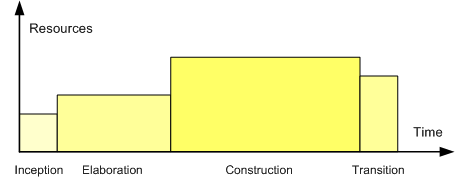|
Unified Process
The Unified Software Development Process or Unified Process is an iterative and incremental software development process framework. The best-known and extensively documented refinement of the Unified Process is the Rational Unified Process (RUP). Other examples are OpenUP and Agile Unified Process. Overview The Unified Process is not simply a process, but rather an extensible framework which should be customized for specific organizations or projects. The ''Rational Unified Process'' is, similarly, a customizable framework. As a result, it is often impossible to say whether a refinement of the process was derived from UP or from RUP, and so the names tend to be used interchangeably. The name ''Unified Process'' as opposed to ''Rational Unified Process'' is generally used to describe the generic process, including those elements which are common to most refinements. The ''Unified Process'' name is also used to avoid potential issues of trademark infringement since ''Rat ... [...More Info...] [...Related Items...] OR: [Wikipedia] [Google] [Baidu] |
Iterative And Incremental Development
Iterative and incremental development is any combination of both iterative design or iterative method and incremental build model for development. Usage of the term began in software development, with a long-standing combination of the two terms ''iterative'' and ''incremental'' having been widely suggested for large development efforts. For example, the 1985 DOD-STD-2167 mentions (in section 4.1.2): "During software development, more than one iteration of the software development cycle may be in progress at the same time." and "This process may be described as an 'evolutionary acquisition' or 'incremental build' approach." In software, the relationship between iterations and increments is determined by the overall software development process. Overview The basic idea behind this method is to develop a system through repeated cycles (iterative) and in smaller portions at a time (incremental), allowing software developers to take advantage of what was learned during development o ... [...More Info...] [...Related Items...] OR: [Wikipedia] [Google] [Baidu] |
Sequence Diagram
A sequence diagram or system sequence diagram (SSD) shows process interactions arranged in time sequence in the field of software engineering. It depicts the processes involved and the sequence of messages exchanged between the processes needed to carry out the functionality. Sequence diagrams are typically associated with use case realizations in the 4+1 architectural view model of the system under development. Sequence diagrams are sometimes called event diagrams or event scenarios. For a particular scenario of a use case, the diagrams show the events that external actors generate, their order, and possible inter-system events. All systems are treated as a black box; the diagram places emphasis on events that cross the system boundary from actors to systems. A system sequence diagram should be done for the main success scenario of the use case, and frequent or complex alternative scenarios. Key elements of sequence diagram A sequence diagram shows, as parallel vertical lines ... [...More Info...] [...Related Items...] OR: [Wikipedia] [Google] [Baidu] |
Project Management
Project management is the process of leading the work of a team to achieve all project goals within the given constraints. This information is usually described in project documentation, created at the beginning of the development process. The primary constraints are scope, time, and budget. The secondary challenge is to optimize the allocation of necessary inputs and apply them to meet pre-defined objectives. The objective of project management is to produce a complete project which complies with the client's objectives. In many cases, the objective of project management is also to shape or reform the client's brief to feasibly address the client's objectives. Once the client's objectives are clearly established, they should influence all decisions made by other people involved in the project – for example, project managers, designers, contractors, and subcontractors. Ill-defined or too tightly prescribed project management objectives are detrimental to decision-maki ... [...More Info...] [...Related Items...] OR: [Wikipedia] [Google] [Baidu] |

